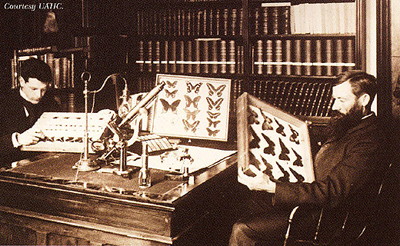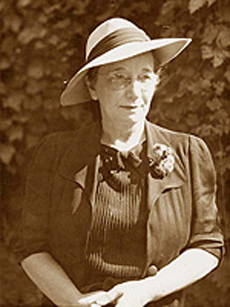History

Albert John Cook, Professor of Zoology and Entomology, established the Collection of Insects at Michigan Agricultural College in 1867. By 1878 the Collection consisted of nearly 1,200 locally-collected specimens used primarily for classroom demonstration, for comparison, and as an aid in species identification for Michigan farmers. It was originally housed in the Library and Museum Building (now Linton Hall).
In 1889, U.S. Senator James McMillan purchased and donated the Fred Tepper Collection of some 12,000 moths and the Austin Collection of 40,000 beetles to the MSU collection, which raised the stature of the collection well beyond teaching. Both of McMillan’s collections were rich in type material – the specimens to which names are tied – thus greatly enhancing the Collection’s research functions. In 1890 additional gifts of Hemiptera from Charles V. Riley at the United States National Museum, a collection of Microlepidoptera from the American Museum of Natural History, a collection of Orthoptera from Dr. Lawrence Bruner of the University of Nebraska, Lincoln, and a collection of Lepidoptera from Dr. Eugene Davenport (an 1878 graduate of the College) of the University of Illinois, made the Michigan Agricultural College collection one of the best college collections in the United States at that time.

Mr. Rufus H. Pettit took over the collection in 1897, and through 1930 added many economically important specimens to the collection, many of them reared from eggs and larvae. Ms. Eugenia McDaniel joined the department in 1910 and by 1949 had added about 400 species of Coccidae, as well as many forest and ornamental tree species. Ms. McDaniel also undertook a research project, which added 8,000 specimens and 1100 species of Noctuidae to the collection between 1937 and 1941. Between 1935 and 1943 Curtis Sabrosky, then an assistant professor and subsequently a world authority on Diptera at the USNM, contributed many specimens of flies, especially of Chloropidae, to the collection. During this time the collection was transferred from the College Museum to the Entomology Department and moved into the Entomology building (now Cook Hall), where it was housed in a brick annex at the back of the building. During this time the specimens were gradually transferred from wooden blocks in insect boxes into cardboard trays placed into drawers.

A 1950 survey determined that the Collection contained more than 100,000 specimens representing some 350 families and 15,000 species. When the construction of the Natural Science Building was completed in 1948, space was allocated for the collection. Built-in cabinets for storage and workspace made expansion possible. In 1952 Dr. Roland Fischer was appointed as Curator of the Insect Collection. He continued in this role until his death in 1992. Dr. Fischer added significantly to the Hymenoptera holdings, his specialty, through collecting, purchases and trades. During the 1960’s the collection was significantly expanded by the accession of several large collections. Dr. Robert Dreisbach, a chemist at Dow Chemical Company in Midland, began a survey of all the insects of Michigan in 1932. He subsequently amassed a collection of over 250,000 insects, which was donated to the MSU collection upon his death. The Walter C. Stinson collection of 7,000 Michigan moths, the Arther Yates collection of 3,000 Michigan moths, the Gunnar Hjegaard collection of some 8,000 Danish moths, and the Thomas Farr collection of some 3,000 Coeloptera and Diptera were also added. Dr. Fred Stehr donated the William C. Stehr collection of 7,000 coccinellid and carabid beetles. Significant contributions were also made by former students, including Dillman S. Bullock with material from Chile, W.T. Van Velzen with material from Peru, Ron Hodges with a collection of Ecuadorian insects, H. Pergama who donated African material, and Julian Donahue, who donated a large collection of Lepidoptera from India.
In the 1970’s and 1980’s the collection continued to grow mainly through collecting by students and researchers. In the 1980’s the collection of Mr. John H. Newman, of South Lyons, Michigan, containing over 10,000 specimens of Lepidoptera, collected from 1941 until his death, came to MSU. Mr. Mogens C. Nielsen contributed many hours of volunteer time and thousands of specimens to the collection over the years since he was a student beginning in 1947. Upon his retirement from the Michigan Department of Natural Resources in 1988, he was appointed as adjunct curator of Lepidoptera, and continues to add significantly to the collection. Because of his and others efforts, the Lepidoptera are perhaps the most completely curated part of the collection. Dr. Fred Stehr took over as Director of the collection in 1988, and in the course of compiling his monumental 2-volume work on Immature Insects, has added significantly to the collection of immatures as well as Lepidoptera in general. Collecting trips by Dr. Stehr to Brasil, Malaysia, Borneo and New Guinea have also added significantly to our foreign species holdings. In the 1990’s. Frank and Anna West have donated significant numbers of insects from Michigan and Latin America to the collection.
In 1999, Mr. Gary Parsons was appointed as the first full-time Collection Manager. As a specialist in Coleoptera, he is working extensively on that part of the collection, which has received relatively little work in the past, and has donated his collection of about 10,000 Coleoptera, most from the western United States. Under his direction, a complete species inventory of all the holdings is being compiled, which will eventually lead to capturing and data-basing the label data for the entire collection.
In 2000, the Collections committee decided to rename the collection (formerly the Center for Arthropod Diversity Studies) to honor Professor Cook and acknowledge his contribution to this collection’s beginnings.
In 2006, Dr. Anthony Cognato joined the faculty as our new molecular systematist and was appointed the new Collection Director to replace the retired Dr. Stehr. Dr. Cognato and his student's research focususes primarily on Scolytinae systematics. He initiated both a physical and electronic expansion of the collection. The collection was expanded into 1,750 square feet and a web-accessible searchable database was created to serve the names of the collections 35,000 species. This work was funded by the collection’s first NSF grant. Based on the success of this grant, Cognato received a subsequent NSF grant to digitally image the entire holdings of the collections. Over 40,000 slides and vials and 400 drawers have been imaged to date.
Summarized in part from:
- W.E. Houk. 1954. A study of some events in the development of Entomology and its application in Michigan. PhD Thesis, Michigan State College of Agriculture (Michigan State University).
- R.L. Fischer. 24 April 1964. Report on the Status of the Entomology Museum at Michigan State University, 1954-1963 – a decade of growth.



 Print
Print Email
Email